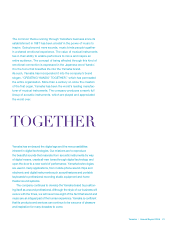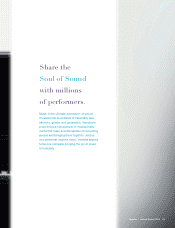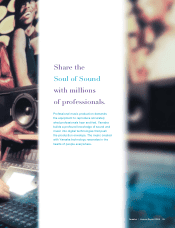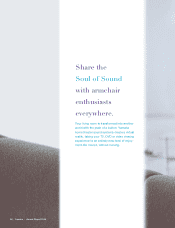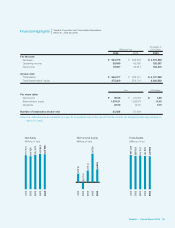Yamaha 2005 Annual Report Download - page 12
Download and view the complete annual report
Please find page 12 of the 2005 Yamaha annual report below. You can navigate through the pages in the report by either clicking on the pages listed below, or by using the keyword search tool below to find specific information within the annual report.
10 Yamaha Annual Report 2005
Fiscal 2005 in review
Covering the period from April 2004 to March 2007, the YSD50 plan commits us to the stable
generation of high earnings, aiming to realize a business structure capable of sustained devel-
opment. In pursuit of these goals, the plan sets out three main policies: “achieving sustainable
development and stable, high earnings,” “creating and developing innovative, high-quality
products and services” and “emphasizing corporate social responsibility (CSR).” The main per-
formance goal is to achieve consolidated operating income of ¥50 billion in fiscal 2007 while
eliminating actual interest-bearing debt completely. In fact, we already succeeded in eliminat-
ing actual interest-bearing debt in fiscal 2005, two years ahead of schedule.
The first year of YSD50 was a key one for creating the conditions necessary for growth in the
coming years. We achieved this by launching several new products to boost sales while under-
taking restructuring unprofitable operations. One of the main thrusts was to boost the earnings
power of our musical instrument business by stimulating the Japanese market using new
approaches. Besides opening new-concept music schools, we also invested in sales bases and
developed business models aimed at attracting customers. Overseas, we reinforced our market-
ing capability in China. On the production side, we invested in overseas manufacturing facilities
and pursued process-based reforms to boost our cost competitiveness.
These efforts did result in an increase in sales of musical instruments, but this was offset
by lower sales in other business segments. Consolidated net sales amounted to ¥534,079 mil-
lion, a fall of 1.0% compared with the previous year. Operating income declined 20.8% to
¥35,695 million. Please refer to the Review of Operations for further details of performance
within each segment.
In fiscal 2005, we elected to adopt fixed-asset impairment accounting standards ahead of
the statutory deadline. This resulted in a related charge of ¥32,703 million. We also booked an
extraordinary gain of ¥19,927 million following an approval in December 2004 to return the
substitutional portion of historical welfare pension funds to the Japanese government. Net
income fell 54.8% to ¥19,697 million.
Fiscal 2005 (the year ended March 2005) was the first year of the Yamaha Group’s
YSD50 medium-term business plan. We aimed to achieve two key objectives during
the year. First, we promoted the specialization and concentration of our business
to create a more profitable base of operations. Second, we clarified strategic
goals for expansion over the longer term. Based on these initiatives, we adopted
fixed-asset impairment accounting standards, notably in the recreation business,
ahead of the statutory deadline, and introduced a series of high-value-added
products and innovative new products during the year. Although we fell short of
the first-year sales and profit targets set out in the YSD50 plan, we will strive to
achieve all plan goals by March 2007.
Sound Management
Message to our Shareholders



